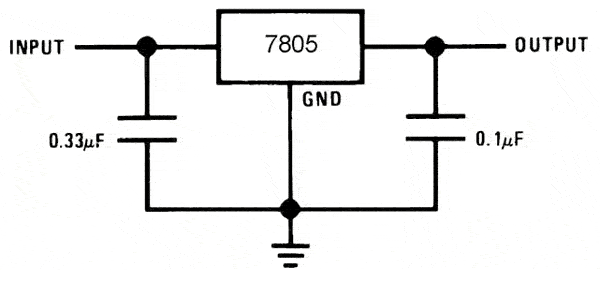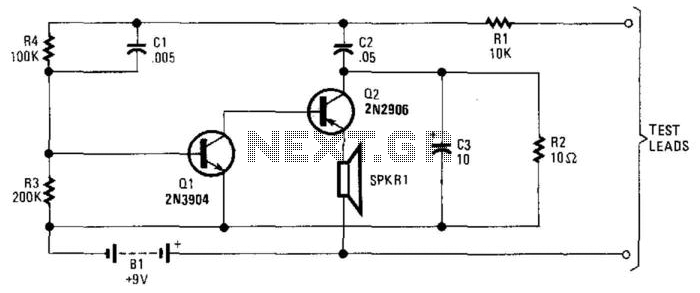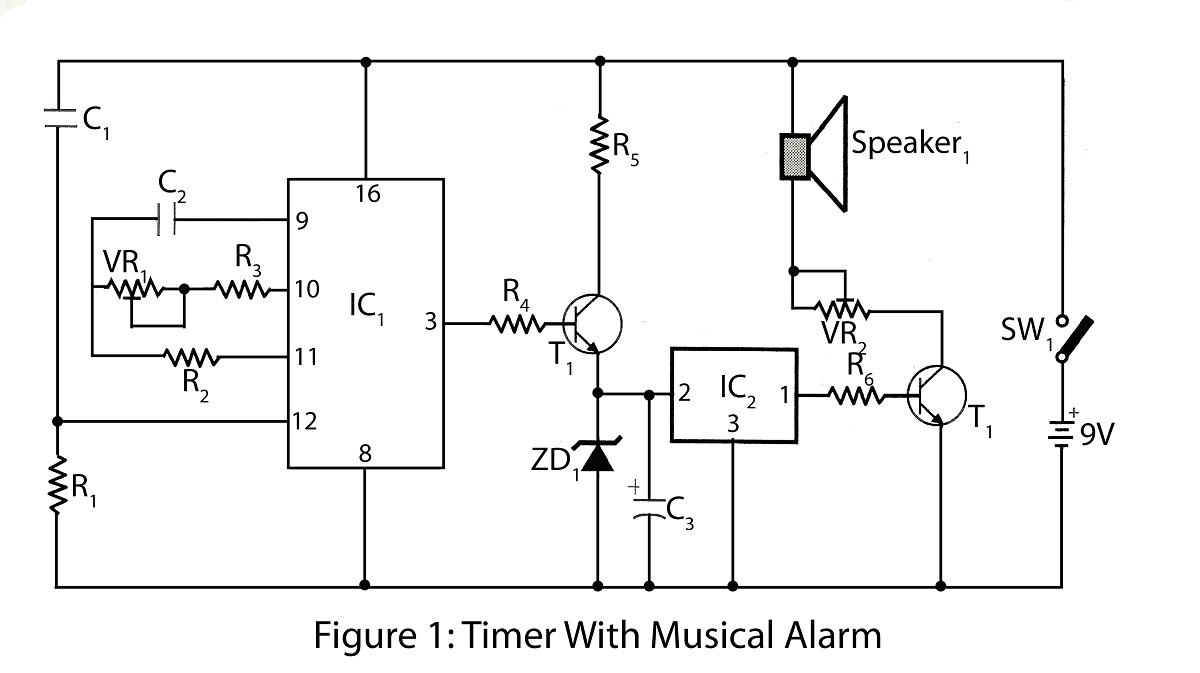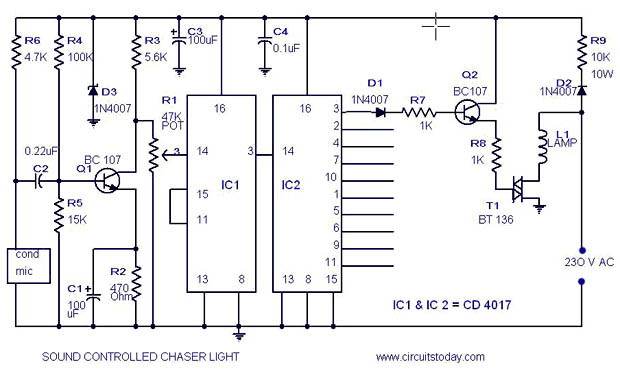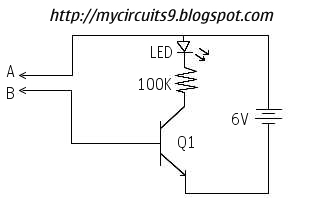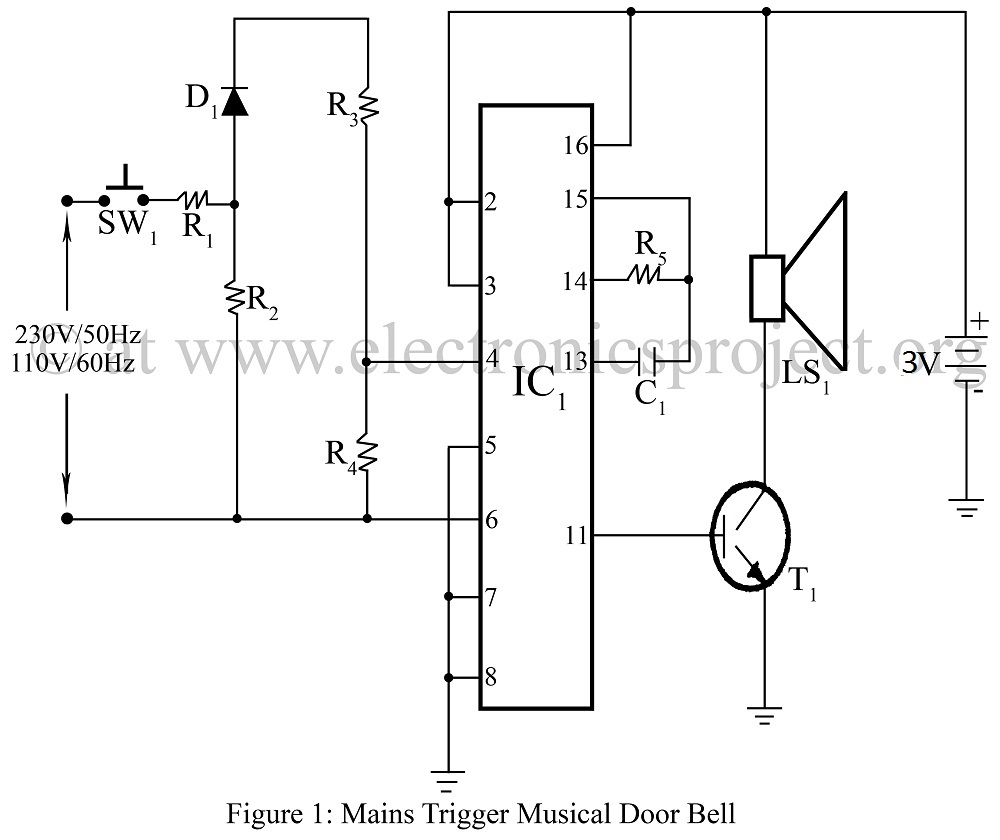
musical continuity
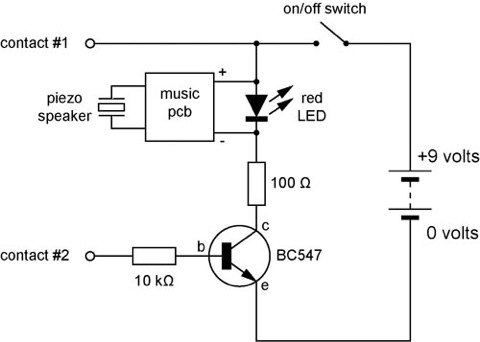
A continuity tester is useful for verifying that there is an electrical conducting path between two points. The circuit described is highly sensitive and provides both visual and audible indications of continuity. An audible tester is advantageous because the user typically focuses on the placement of the tester contacts rather than on the tester itself. The circuit diagram illustrates that the continuity tester consists of a sensitive one-transistor switch that activates both an LED and a circuit derived from a musical greeting card. Most greeting card circuits are powered by a single 1.5-volt "hearing aid" cell, so the music printed circuit board (PCB) is connected across the red LED, which maintains a relatively constant voltage of approximately 1.5 volts across it. Some musical circuits utilize two cells, allowing the LED to be replaced with a green, blue, or white one to increase the voltage across the PCB. The base resistor value is not critical; a 10 kΩ resistor is specified, but a 100 kΩ resistor functions similarly. The collector resistor (100 Ω) is also not highly critical. Using higher values will limit the current through the music PCB and LED, resulting in quieter and slower music, with a slight effect on pitch. Two musical greeting card PCBs and their piezo speakers are depicted in the accompanying image. The one on the left remains unmodified, retaining its cell, cell holder, and on/off switch, while these components have been removed from the PCB on the right. Another photo displays the soldered components. The contacts used are connected to 4 mm "banana" sockets, enhancing the circuit's versatility by allowing various probes or connectors to be attached. Two views of the completed musical continuity tester in its enclosure are shown. The piezo speaker leads were unsoldered from the PCB and threaded through two small holes drilled into the box before being re-soldered onto the PCB. The red LED is affixed to the box and connected via flying leads to the PCB. The banana sockets are mounted on either side of the box. As a moisture tester, this circuit is sensitive enough to function when the two contacts are placed in damp soil or on a wet wall. Human skin is sufficiently moist to trigger the circuit. This setup can also be used to demonstrate to students that components must be connected in a closed loop for the circuit to function. A class can form a circle and hold hands, with two volunteers designated to hold the tester such that one touches one socket/contact and the other touches the second socket/contact without touching the first volunteer. When all participants hold hands, the music plays, and the instructor can point to various partners to momentarily break the connection, causing the music to stop and then resume when they reconnect. This activity illustrates the concept of being "connected" in a series circuit. Additionally, the circuit can serve as the base for a skill game, where a wiggly length of rigid wire (such as florist's wire or a bent coat hanger) is connected to one socket, and a small wire loop is attached to the other socket using a flexible lead. The objective of the game is to maneuver the loop along the wiggly wire without making contact, which would trigger the music.
The continuity tester circuit employs a simple yet effective design that integrates a single transistor as a switch, allowing for both visual (LED) and audible (musical output) feedback. The transistor's base is connected to a resistor that limits the current, ensuring that the transistor operates within its safe limits while maintaining sensitivity. The LED serves as a visual indicator of continuity, illuminating when a conductive path is established. The incorporation of a musical greeting card circuit adds an engaging auditory element, making the tester more interactive.
The choice of components, such as the piezo speaker and the flexibility of the banana sockets, enhances the circuit's usability in various applications, from educational demonstrations to practical testing in moist environments. The design is versatile enough to accommodate different LED colors based on the power supply used, allowing for customization depending on user preference or specific application requirements.
In educational settings, the circuit serves as an excellent tool to illustrate fundamental concepts of electrical circuits, such as closed loops and series connections. The interactive nature of the activity fosters engagement and enhances understanding among participants. Furthermore, the circuit's adaptability for use as a game adds an element of fun, making learning about electrical principles more enjoyable. Overall, the continuity tester circuit is a practical and effective tool for both educational and practical applications in electronics.A continuity tester is handy for checking that there is an electrical conducting path between two points. The following circuit has the advantage that it is very sensitive and it gives both a visual and audible indication of continuity.
An audible tester is handy since you are normally looking at where you are placing the tester contacts rather th an looking at the tester itself. The circuit diagram shows that the continuity tester is made up of a sensitive one-transistor switch which turns on both a LED and a circuit taken from a musical greeting card. Most greeting card circuits are powered by a single 1. 5 volt "hearing aid" cell so I have connectedthe music printed circuit board (pcb) across the red LED which maintains a fairly constant voltage of about 1.
5 volts across it. Some musical circuits use two cells so you could change the LED to a green, blue or white one which would increase the voltage across the pcb. The base resistor value is not critical. I have specified 10 k © here but its purpose really is only to limit the maximum current that can pass through the base-emitter part of the transistor.
A value of 100 k © seems to work just as well. Again the collector resistor (100 ©) is not too critical. Higher values will limit the current through the music pcb and LED making the music quieter and slower. The music`s pitch may may also be affected a little. Two musical greeting card printed circuit boards (pcbs) and their piezo speakers are shown in the picture alongside.
The one on the left is unmodified and has its cell, cell holder and off/on switch still attached. These have been removed from the pcb on the right. This next photo shows the components soldered together. The contacts used here are connected to 4 mm "banana" sockets. This makes the circuit more versatile since a range of probes or connectors can be attached to the sockets. Below are two views of the finished musical continuity tester in its box. The piezo speaker leads were unsoldered from the pcb and fed through two small holes drilled into the box before being soldered back onto the pcb.
The red LED is glued to the box and attached by flying leads to the pcb. The banana sockets are attached on either side of the box. As a moisture tester. This circuit is sensitive enough to operate when the two contacts are placed in damp soil or on a damp wall. Your skin is moist enough to trigger the circuit - see the next use. To demonstrate to students that components need to be connected in a closed loop for a circuit to work.
Get a class of students to form a circle and hold hands. Get two adjacent volunteers - one to hold the tester in such a way that their index finger touches one socket/contact. The other volunteer touches just the other socket/contact (making sure not to touch the first volunteer).
Once all are holding hands the music plays and I point to various partners to momentarily break from holding hands - the music stops and then resumes when they hold hands again. I also make sure the students realise they are "connected" together in a series circuit. As the base circuit for a game of skill like "operation". A wiggly length of rigid wire (florist`s wire or a bent coat hanger) is connected to one socket. A small wire loop is attached to the other socket using a flexible wire lead. The aim of the game is to move the loop along the wiggly wire without touching it and setting off the music.
🔗 External reference
The continuity tester circuit employs a simple yet effective design that integrates a single transistor as a switch, allowing for both visual (LED) and audible (musical output) feedback. The transistor's base is connected to a resistor that limits the current, ensuring that the transistor operates within its safe limits while maintaining sensitivity. The LED serves as a visual indicator of continuity, illuminating when a conductive path is established. The incorporation of a musical greeting card circuit adds an engaging auditory element, making the tester more interactive.
The choice of components, such as the piezo speaker and the flexibility of the banana sockets, enhances the circuit's usability in various applications, from educational demonstrations to practical testing in moist environments. The design is versatile enough to accommodate different LED colors based on the power supply used, allowing for customization depending on user preference or specific application requirements.
In educational settings, the circuit serves as an excellent tool to illustrate fundamental concepts of electrical circuits, such as closed loops and series connections. The interactive nature of the activity fosters engagement and enhances understanding among participants. Furthermore, the circuit's adaptability for use as a game adds an element of fun, making learning about electrical principles more enjoyable. Overall, the continuity tester circuit is a practical and effective tool for both educational and practical applications in electronics.A continuity tester is handy for checking that there is an electrical conducting path between two points. The following circuit has the advantage that it is very sensitive and it gives both a visual and audible indication of continuity.
An audible tester is handy since you are normally looking at where you are placing the tester contacts rather th an looking at the tester itself. The circuit diagram shows that the continuity tester is made up of a sensitive one-transistor switch which turns on both a LED and a circuit taken from a musical greeting card. Most greeting card circuits are powered by a single 1. 5 volt "hearing aid" cell so I have connectedthe music printed circuit board (pcb) across the red LED which maintains a fairly constant voltage of about 1.
5 volts across it. Some musical circuits use two cells so you could change the LED to a green, blue or white one which would increase the voltage across the pcb. The base resistor value is not critical. I have specified 10 k © here but its purpose really is only to limit the maximum current that can pass through the base-emitter part of the transistor.
A value of 100 k © seems to work just as well. Again the collector resistor (100 ©) is not too critical. Higher values will limit the current through the music pcb and LED making the music quieter and slower. The music`s pitch may may also be affected a little. Two musical greeting card printed circuit boards (pcbs) and their piezo speakers are shown in the picture alongside.
The one on the left is unmodified and has its cell, cell holder and off/on switch still attached. These have been removed from the pcb on the right. This next photo shows the components soldered together. The contacts used here are connected to 4 mm "banana" sockets. This makes the circuit more versatile since a range of probes or connectors can be attached to the sockets. Below are two views of the finished musical continuity tester in its box. The piezo speaker leads were unsoldered from the pcb and fed through two small holes drilled into the box before being soldered back onto the pcb.
The red LED is glued to the box and attached by flying leads to the pcb. The banana sockets are attached on either side of the box. As a moisture tester. This circuit is sensitive enough to operate when the two contacts are placed in damp soil or on a damp wall. Your skin is moist enough to trigger the circuit - see the next use. To demonstrate to students that components need to be connected in a closed loop for a circuit to work.
Get a class of students to form a circle and hold hands. Get two adjacent volunteers - one to hold the tester in such a way that their index finger touches one socket/contact. The other volunteer touches just the other socket/contact (making sure not to touch the first volunteer).
Once all are holding hands the music plays and I point to various partners to momentarily break from holding hands - the music stops and then resumes when they hold hands again. I also make sure the students realise they are "connected" together in a series circuit. As the base circuit for a game of skill like "operation". A wiggly length of rigid wire (florist`s wire or a bent coat hanger) is connected to one socket. A small wire loop is attached to the other socket using a flexible wire lead. The aim of the game is to move the loop along the wiggly wire without touching it and setting off the music.
🔗 External reference
